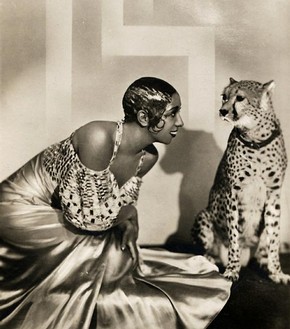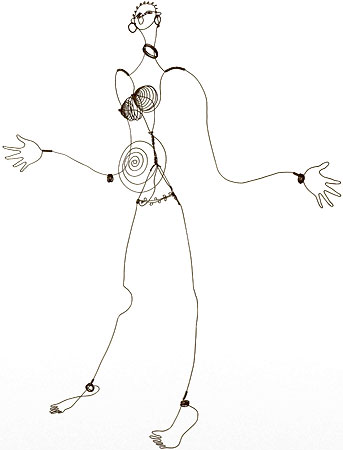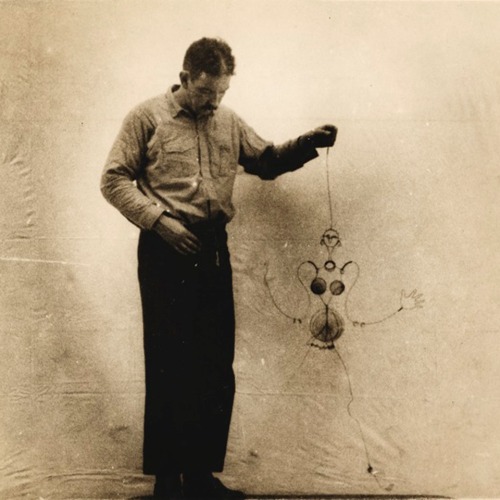
Diana Vreeland, Empress of Fashion, 1903-1989
Before her career as editor and columnist at fashion magazines Harper’s Bazaar and Vogue, Diana Vreeland, like other society women of her class, ran a little lingerie shop near Berkeley Square in London. She often traveled to Paris where she would buy her clothes, notably, Chanel. She remembered one such trip in the summer of 1932:
“One night in Paris, after I was married, a friend and I went to a little theatre above Montmartre to see a German[-French] movie called “L’Atlantide,” with a wonderful actress in it called Brigitte Helm, who played the Queen of the Lost Continent. It was the middle of July. It was hot. The only seats in the theatre were in the third balcony, under the rafters, where it was even hotter. There were four seats in a row, and we took two.

“We sat there, the movie started…and I became totally intoxicated by it. I was mesmerized! …I was absorbed by these three lost Foreign Legion soldiers with their camels, their woes…they’re so tired, they’re delirious with dehydration…And then you see the fata morgana [mirage]. That means that if you desire a woman, you see a woman, if you desire water, you see water – everything you dream, you see. But you never reach it. It’s all an illusion.
“Then…a sign of an oasis! There’s a palm…and more palms. Then they’re in the oasis, where they see Brigitte Helm, this divine looking woman seated on a throne – surrounded by cheetahs! The cheetahs bask in the sun. She fixes her eyes on the soldiers. One of them approaches her. She gives him a glass of champagne and he drinks it. Then she takes the glass from him, breaks it, cuts his throat with it…

Brigette Helm as the Queen of Atlantis, the Lost Continent, shown here with one of her screen cheetahs. “L’Atlantide” (1932)
“This goes on and on. I hadn’t moved an inch. At some point I moved my hand…to here…where it stayed for the rest of the movie. I was spellbound because the mood was so sustained. I was sucked in, seduced by this thing of the desert, seduced by the Queen of the Lost Continent, the wickedest woman who had ever lived…and her cheetahs!
The essence of movie-ism.
“Then…the lights went on, and I felt a slight movement under my hand. I looked down – and it was a cheetah! And beside the cheetah was Josephine Baker!”

When Josephine Baker began performing her exotic, erotic, and peculiar dances in Paris cabarets in 1925, she became an instant hit, a superstar. In the thirties, she was the most successful American entertainer working in France. She was known as “The Black Pearl” and “The Bronze Venus.” Whether sitting high up in a giant bird cage covered with peacock feathers or dancing semi-nude in a skirt of dangling fabric bananas, audiences were captivated by her infectious charm. ca. 1925
Meanwhile, back to our story:
Diana Vreeland was chatting with Josephine Baker in the balcony of a hot theater, looking at a cheetah.
Diana says to Josephine:
“‘Oh,” I said, ‘you’ve brought your cheetah to see the cheetahs!’
“Yes,” she said,’ that’s exactly what I did.’
“She was alone with the cheetah on a lead. She was so beautifully dressed. She was wearing a marvelous little short black skirt and a little Vionnet shirt – no sleeves, no back, no front, just crossed bars on the bias. Don’t forget how hot it was, and, of course, the great thing was to get out of this theatre we were in. The cheetah, naturally, took the lead, and Josephine, with those long black legs, was dragged down three flights of stairs as fast as she could go, and that’s fast.
“Out in the street there was an enormous white-and-silver Rolls-Royce waiting for her. The driver opened the door; she let go of the lead; the cheetah whooped, took one leap into the back of the Rolls, with Josephine right behind; the door closed…and they were off!
…Ah! Style was a great thing in those days.” (1)

American entertainer Josephine Baker (1906-1936) often performed onstage in Paris nightclubs with pet cheetah Chiquita. Chiquita wore a diamond collar. Sometimes, during a performance, Chiquita would decide to jump off the stage and into the orchestra pit, causing quite a ruckus. ca. 1931. Courtesy of Victoria and Albert Museum.

Heads turned when entertainer Josephine Baker took her pet cheetah Chiquita on a walk, sometimes down the Champs-Élysées in Paris. Ca. 1930

Sheet music with Josephine Baker and Chiquita.
Comparing Josephine Baker to a beautiful Egyptian queen, artist Pablo Picasso dubbed her “the Nefertiti of Now.” She posed for him in all her glory: “tall, coffee skin, ebony eyes, legs of paradise, a smile to end all smiles.” (2)

Gorgeous, talented, and funny Josephine Baker, an original. Undated photo, ca. 1930
(1)Vreeland, Diana. D.V. New York: Da Capo Press, 1984
(2) Picasso quote
Read Full Post »




 In 1939, France declared war on Nazi Germany for its invasion of Poland. Within nine months, the Nazis invaded France. Baker was recruited by the Deuxiéme Bureau, the French Military Intelligence, as an “honorable correspondent.” She was so well-known and popular that even the Nazis were hesitant to cause her harm. She made the perfect spy. As an entertainer, she had good excuses for traveling, which allowed her to smuggle secret orders and maps written in invisible ink on her musical sheets. On some occasions, Baker would smuggle secret photos of German military installations out of enemy territory by pinning them to her underwear. To operatives in the French Resistance as well as U.S. and British agents, she relayed information on German troop movements she had gleaned from conversations she overheard between officials with whom she mingled following her performances or at embassy and ministry parties. She also exposed French officials working for the Germans. She hid Jewish refugees and weapons in her 24-room château in the South of France.
In 1939, France declared war on Nazi Germany for its invasion of Poland. Within nine months, the Nazis invaded France. Baker was recruited by the Deuxiéme Bureau, the French Military Intelligence, as an “honorable correspondent.” She was so well-known and popular that even the Nazis were hesitant to cause her harm. She made the perfect spy. As an entertainer, she had good excuses for traveling, which allowed her to smuggle secret orders and maps written in invisible ink on her musical sheets. On some occasions, Baker would smuggle secret photos of German military installations out of enemy territory by pinning them to her underwear. To operatives in the French Resistance as well as U.S. and British agents, she relayed information on German troop movements she had gleaned from conversations she overheard between officials with whom she mingled following her performances or at embassy and ministry parties. She also exposed French officials working for the Germans. She hid Jewish refugees and weapons in her 24-room château in the South of France.




























